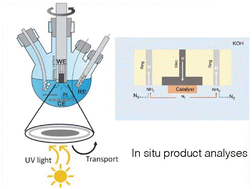A rotating ring disc electrode study of photo(electro)catalyst for nitrogen fixation
Abstract
There are numerous reports of photo(electro)catalysts demonstrating activity for nitrogen reduction to ammonia and a few reports of photo(electro)catalysts demonstrating activity for nitrogen oxidation to nitric acid. However, progress in advancing solar-to-fertilizer applications is slow, due in part to the pace of catalyst screening. Most evaluations of photo(electro)catalysts activity occur using batch reactors. This is because common product analyses require accumulation of ammonia or nitric acid in the reactor to overcome instrument detection limits. The primary aim here is to examine the use of an electroanalytical method, rotating ring disk electrode voltammetry (RRDE), to detect ammonia produced by a nitrogen fixing photo(electro)catalyst. To examine the potential for RRDE, we investigated a photo(electro)catalyst known to reduce nitrogen to ammonia (titania), while varying the applied electrochemical potential and degree of illumination on the disk. We show that the observed ammonia oxidation at the ring electrode corresponds strongly with ammonia measurements obtained from the bulk electrolyte. Indicating that RRDE may be effective for catalyst screening. The chief limitation of this approach is the need for an alkaline electrolyte. In addition, this approach does not rule out the presence of adventitious ammonia.

- This article is part of the themed collection: Sustainable nitrogen activation


 Please wait while we load your content...
Please wait while we load your content...